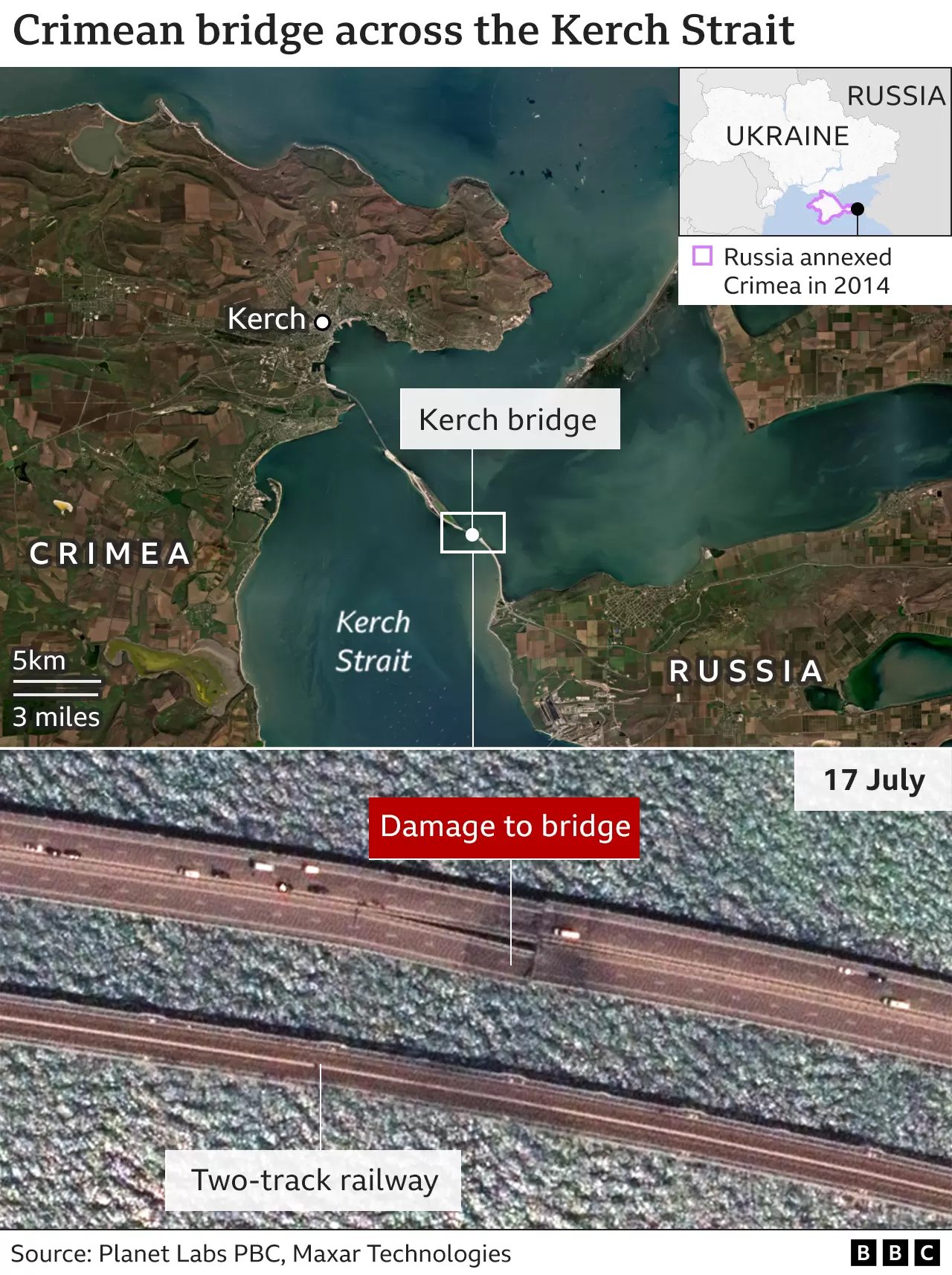A drone attack on an ammunition depot in Crimea has led to civilian evacuations and disrupted transport, Russian authorities have said.
Sergei Aksyonov, the Russian-installed governor of occupied Crimea, said Ukraine was behind the attack, without providing evidence.
Mr Aksyonov said local residents living within five kilometres of the blast were being evacuated.
Rail services across the Kerch bridge have also reportedly been halted.
Earlier on Saturday, Russian authorities stopped traffic on the bridge, but then swiftly reopened it to cars.
A later update from the Moscow-installed government said road traffic was again halted until further notice.
Mr Aksyonov said infrastructure facilities in the Krasnogvardeysky district in Crimea were the target.
“According to preliminary data, there were no damages or casualties,” Mr Aksyonov wrote on a Telegram post.
The BBC has not been able to independently verify the attack.
The Kerch bridge, often referred to as the Crimea bridge, was opened in 2018 and it enables road and rail access between Russia and Crimea - Ukrainian territory annexed by Russia in 2014.
The bridge has become a symbol of Russian occupation and is also an important re-supply route for Russian forces in southern Ukraine.
On Monday, a blast on the bridge killed two people and damaged the road but the railway line, which runs parallel to it, was not damaged.
The Kremlin blamed Kyiv for Monday’s attack and said Ukraine had carried out a “terrorist” act. Russian President Vladimir Putin vowed to retaliate and accused Ukraine of launching a “senseless” and “cruel” attack.


Ukrainian President Volodymyr Zelensky has said the Crimea bridge is a legitimate target.
Speaking on Friday he said the bridge was “the route used to feed the war with ammunition and this is being done on a daily basis”, adding that Kyiv sees it as “an enemy facility”.
“So, understandably, this is a target for us,” Mr Zelensky said, in a video address to the Aspen security conference in the US.
Monday’s alleged attack was the second major incident on the Kerch bridge in the past year.
In October 2022, the bridge was partially closed following a huge explosion. It was fully reopened in February.


You’re just spitballing about the “pop the top” “slam back down” in a useful way, right? I mean, Russia showed it could mend the bridge already, so the explosive payload that Ukraine can deliver or how it is being deployed is insufficient to render the bridge useless. It very well could be psyops—packing just enough punch to choke down the bandwidth of the bridge and encouraging the civilians there to second guess their decision to remain.
EDIT: I’m seeing others on here who are getting downvoted for suggesting that the attack on the road is a terror attack. I found myself at first thinking, “fuck these people, it’s fine.” Then I felt bad and wondered if there is some rule about it, but I didn’t search. Now I’m finding myself defining the issue: what are the ethics of a State at war, in furthering the defense of its sovereignty and territorial integrity, intentionally scaring a occupying civilian population to encourage it to leave, while avoiding any direct action against the population itself?
War fucking sucks. When Ukraine successfully drives back the occupation… by the power of Grayskull it will be a time for wisdom and grace.
No, I meant it in a completely serious way. The explosion might be been powerful enough to lift the decking of the bridge straight up and sheared a lot of connection points in the girder and headers, but depending oh how much force was directed perpendicularly, it might have just caused it to slam down on top of the caps and pillars and just sit there with a really bad weight distribution.
In terms of functionality, that sort of damage is better compared to maybe a cracked windshield, as an analogy? You can keep trucking along and maybe everything will be fine, but the overall structural integrity of the windshield is now in a much riskier state. Any further strikes could cause further destabilization radiating outward from the flaw or worse, the continued use could be causing the material to continually weaken as stress points are flexed over and over and over and over. Similar to how if you bend a stiff piece of metal back and forth, it gets looser and eventually snaps.
The photos Russia themselves published show levels of damage that would take, at minimum, days to weeks to fix back to perfect assuming you’re running everything as an emergency 24/7 rush job, and realistically more likely months since you’re not likely to have a super dense civilian engineering firm able to just instantly slide into place. The more likely case is that Ukraine caused damage that drastically weakened that section of the bridge, but didn’t hit it in such a way as to do much more reduce the weight load that can go over or it alternatively drastically shorten the lifespan of the bridge without major repair. That seems pretty consistent with what you’d expect out of a drone bomb blowing up under the bridge, rather than something coming in and hitting it from the side, like a missile or something impacting from the top down.
Russia is leaning on the thought that the patch job will hold longer than the state of hostilities and that they can do more long term repairs once things have cooled off some. But for now, supplies NEED to be run over that bridge, so fast patch and reduced weight and lifetime is the cost they pay.